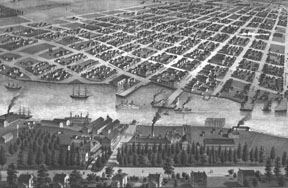SUCCESS
OF VALLEJO AND ITS FERRIES: LOCATION, LOCATION FOR THE PAST 150
YEARS
By F. Weston Starratt
 |
| Retro
Vallejo Ferry the "General Frisbie" Photo courtesy
Vallejo Naval and Historical Museum. |
The importance of Vallejo’s
location was apparent even before the city’s founding. General
Mariano Vallejo, the last Mexican Governor of California, realized
that the little settlement was a natural transportation hub where
land meets water at the gateway to the Bay Area from the great
central valley. He was so enthusiastic about the area that he
offered some of his own land and even succeeded in making Vallejo
the capital of the State of California, at least for one year. To
General Vallejo, Vallejo was the "true center of the
state."
The United States Navy
established the Mare Island Navy Yard in 1856, with regularly
scheduled connections established to Vallejo soon thereafter. A few
years later, railroad barons also grasped the vision of the
settlement as a center of commerce. They found that Vallejo was the
closest location to San Francisco on the west side of the Sacramento
River and the true "Gateway to the Bay Area." So, bBy
1869, the California Pacific Railroad established a ferry terminal
in South Vallejo connecting to railroad lines leading all the way to
Sacramento. Later, competition set in, and the Central Pacific
developed a land-based route from Sacramento along the south shore
of the river, with ferry connections to Vallejo at Crockett. The
result was that direct ferry service from Vallejo to San Francisco
ended by 1883 … but not for long.
Others continued to see
Vallejo as a prime transportation hub, and direct ferry service to
San Francisco was re-established in 1890, connecting to railroads
serving Benicia, Napa Valley, and Calistoga. One firm even had a
ship that could make the 26 nautical mile run to San Francisco in
only two hours. In 1900, a new vessel, the General Frisbie
(named for General Vallejo’s son in law), was built and put in
service. In 1908, a new electric railway line connecting ferries to
San Francisco with the City of Napa, Yountville, St. Helena, and
Calistoga in the Napa Valley opened for business.
 |
| Old
Vallejo |
During World War I,
additional vessels were put in service to transport workers to the
booming Mare Island Navy Yard. By 1922, these vessels were being
converted to handle a new type of cargo, automobiles. The Southern
Pacific Golden Gate Ferries entered the picture about that time,
bought out the older steamship lines, and continued regular
passenger and automobile service from Vallejo to San Francisco until
1936 1937 when the direct highway access over the new Bay Bridge
bridges eliminated the need. diverted most patronage to highways.
Ferry service between Vallejo and San Francisco was discontinued in
1937. This also led to the demise of electric train service between
Vallejo and the Napa Valley.For a period of almost 50 years, from
1936 to 1986, Vallejo and most of the Bay Area, were without regular
ferry service
A New Beginning, Sparked by
Waterfront Redevelopment
(For much of the rest of
our story, we are grateful to information provided by Alvaro da
Silva, Director of Community Development for the City of Vallejo,
and Pamela J. Belchamber, Transportation Superintendent for the city
and the driving force behind the creation of Vallejo’s Baylink
ferry system.)
The heyday of Vallejo’s
waterfront occurred during World War II when the Mare Island Naval
Shipyard was in full operation and sailors roamed the streets 24
hours per day. After the war, the waterfront sank into a decaying
undeveloped area with makeshift docks, and boat repair yards, cafes,
bars, and more. That scene changed dramatically with a mMassive
urban renewal program in the late 1950s and early 1960s that
transformed the waterfront, into a vibrant area with new boat ramps,
open space and esplanades, and that focusedfocusing on a splendid
new city hall and library. civic center complex.
CONTINUE